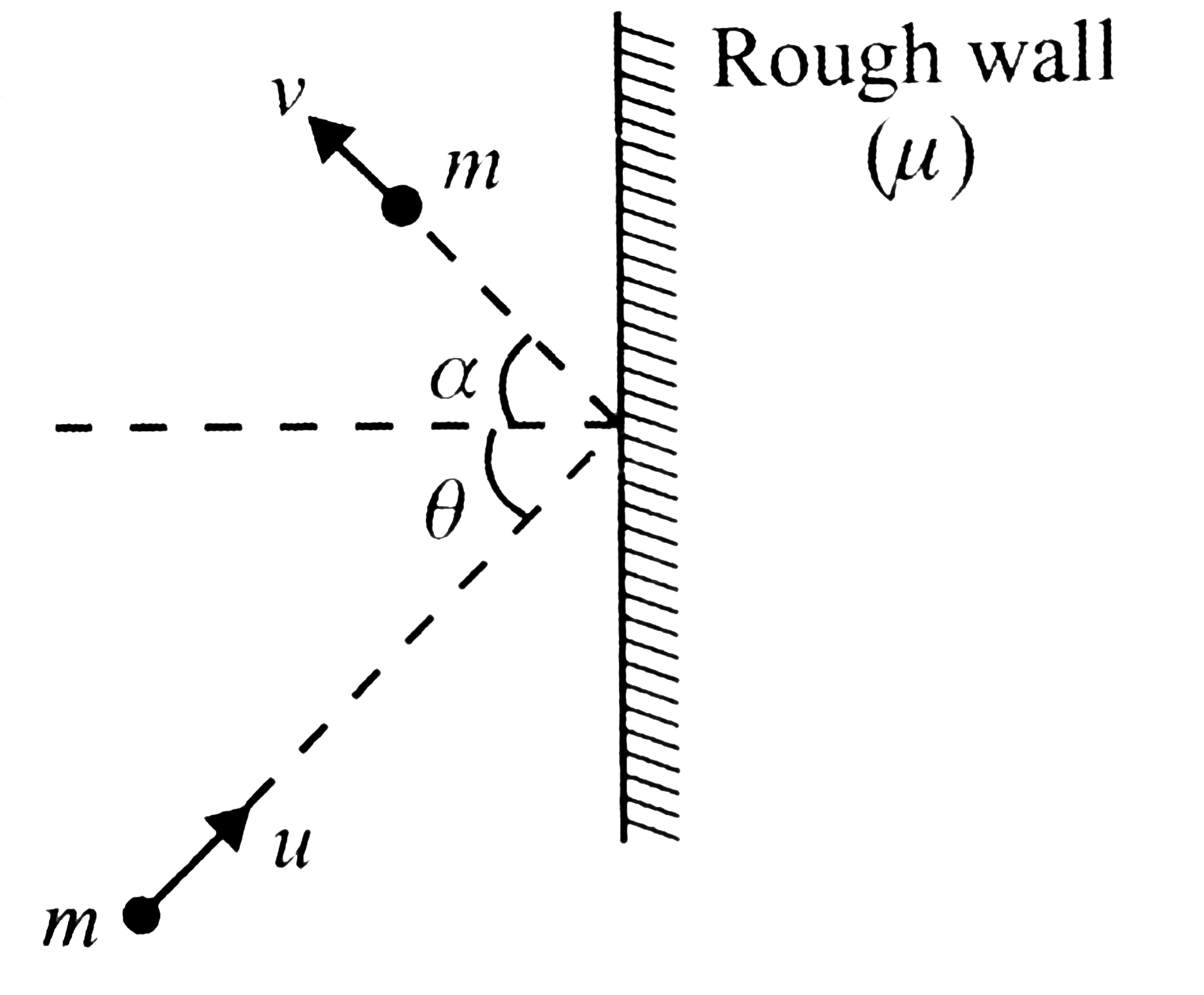A ball of mass m hits a floor with a speed v0 making an angle of incidence α with the normal. The coefficient of restitution is e. Find the speed of the reflected ball and the angle of reflection of the ball.
The correct Answer is:A, B
To solve the problem, we will break down the motion of the ball into its components and apply the principles of collision and the coefficient of restitution.
1. Identify the Components of the Initial Velocity:
The ball hits the floor with an initial speed v0 at an angle α with the normal. We can break this velocity into two components:
- Normal Component (perpendicular to the floor):
vn=v0cosα
- Tangential Component (parallel to the floor):
vt=v0sinα
2. Apply the Coefficient of Restitution:
The coefficient of restitution e relates the velocities before and after the collision in the normal direction. The velocity of separation after the collision in the normal direction v′n is given by:
e=v′nvn
Rearranging gives:
v′n=evn=e(v0cosα)
3. Determine the Tangential Component After Collision:
The tangential component of the velocity remains unchanged during the collision (assuming no friction). Therefore:
v′t=vt=v0sinα
4. Calculate the Magnitude of the Final Velocity:
The final velocity v of the ball after the collision can be found using the Pythagorean theorem:
v=√(v′n)2+(v′t)2
Substituting the values we have:
v=√(ev0cosα)2+(v0sinα)2
Simplifying this gives:
v=√e2v20cos2α+v20sin2α
v=v0√e2cos2α+sin2α
5. Determine the Angle of Reflection:
Let β be the angle of reflection with respect to the normal. The relationship between the tangential and normal components after the collision gives us:
tanβ=v′tv′n=v0sinαev0cosα
This simplifies to:
tanβ=sinαecosα
Therefore, the angle of reflection β can be expressed as:
β=tan−1(tanαe)
Final Results:
- The speed of the reflected ball is:
v=v0√e2cos2α+sin2α
- The angle of reflection is:
β=tan−1(tanαe)
The ball hits the floor with an initial speed v0 at an angle α with the normal. We can break this velocity into two components:
- Normal Component (perpendicular to the floor):
vn=v0cosα
- Tangential Component (parallel to the floor):
vt=v0sinα
The coefficient of restitution e relates the velocities before and after the collision in the normal direction. The velocity of separation after the collision in the normal direction v′n is given by:
e=v′nvn
Rearranging gives:
v′n=evn=e(v0cosα)
The tangential component of the velocity remains unchanged during the collision (assuming no friction). Therefore:
v′t=vt=v0sinα
The final velocity v of the ball after the collision can be found using the Pythagorean theorem:
v=√(v′n)2+(v′t)2
Substituting the values we have:
v=√(ev0cosα)2+(v0sinα)2
Simplifying this gives:
v=√e2v20cos2α+v20sin2α
v=v0√e2cos2α+sin2α
Let β be the angle of reflection with respect to the normal. The relationship between the tangential and normal components after the collision gives us:
tanβ=v′tv′n=v0sinαev0cosα
This simplifies to:
tanβ=sinαecosα
Therefore, the angle of reflection β can be expressed as:
β=tan−1(tanαe)
- The speed of the reflected ball is:
v=v0√e2cos2α+sin2α
- The angle of reflection is:
β=tan−1(tanαe)
Topper's Solved these Questions
- CENTRE OF MASS, LINEAR MOMENTUM AND COLLISIONBOOK - DC PANDEY ENGLISHCHAPTER - CENTRE OF MASS, LINEAR MOMENTUM AND COLLISIONEXERCISE - Type 1
1 Videos
- CENTRE OF MASS, LINEAR MOMENTUM AND COLLISIONBOOK - DC PANDEY ENGLISHCHAPTER - CENTRE OF MASS, LINEAR MOMENTUM AND COLLISIONEXERCISE - Solved Examples
13 Videos
- CENTRE OF MASS, IMPULSE AND MOMENTUMBOOK - DC PANDEY ENGLISHCHAPTER - CENTRE OF MASS, IMPULSE AND MOMENTUMEXERCISE - Comprehension type questions
15 Videos
- CIRCULAR MOTIONBOOK - DC PANDEY ENGLISHCHAPTER - CIRCULAR MOTIONEXERCISE - Medical entrances s gallery
19 Videos
Similar Questions
A ball of a mass m hits the floor with as speed v making an angle of incidence θ with the normal. The coefficient of restitution is e. Find the speed of the reflected ball and the angle of reflection of the ball.

View SolutionA small ball of mass m collides with as rough wal having coeficient of friction μ at an angle θ with the normal to the wall. If after collision the ball moves wilth angle α with the normal to the wall and the coefficient of restitution is e, then find the reflected velocity v of the ball just after collision.

View Solution
Knowledge Check
A ball of mass m moving with a speed 2v0 collides head-on with an identical ball at rest. If e is the coefficient of restitution, then what will be the ratio of velocity of two balls after collision?
A1−e1+eBe−1e+1C1+e1−eDe+1e−1A ball of mass m moving with a speed 2v0 collides head-on with an identical ball at rest. If e is the coefficient of restitution, then what will be the ratio of velocity of two balls after collision?
A1−e1+eB1+e1−eCe−1e+1De+1e−1
A particle of mass m strikes a horizontal smooth floor with velocity u making an angle θ with the floor and rebound with velocity v making an angle θ with the floor. The coefficient of restitution between the particle and the floor is e. Then
View SolutionA ball of mass 2kg moving with speed 5m/s collides directly with another ball of mass 3kg moving in the same direction with speed 4m/s. The coefficient of restitution is 2/3. Find the velocities of both ball after the collision.
View SolutionA ball strickes a horizontal floor at an angle θ=45∘ with the normal to floor. The coefficient of restitution between the ball and the floor is e=1/2. The fraction of its kinetic energy lost in the collision is.
View SolutionA ball strickes a horizontal floor at an angle θ=45∘ with the normal to floor. The coefficient of restitution between the ball and the floor is e=1/2. The fraction of its kinetic energy lost in the collision is.
View SolutionTwo balls of equal mass have a head-on collision with speed 6m/s. If the coefficient of restitution is 13, find the speed of each ball after impact in m/s
View SolutionThe first ball of mass m moving with the velocity υ collides head on with the second ball of mass m at rest. If the coefficient of restitution is e, then the ratio of the velocities of the first and the second ball after the collision is
View Solution
